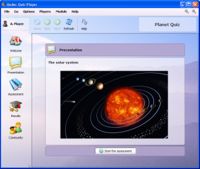Case Studies/Qedoc Interactive Educational Resources
—
Overview
As of April 2009, Qedoc offers over 1000 interactive learning resources, mostly either sets of quizzes or flashcards. The 1000 modules include around 4000 activites, 65000 questions and thousands of images and recordings. The project caters for around a dozen languages, although English currently dominates, followed by Spanish.
In terms of subject coverage, Qedoc has particularly large numbers of resources in the areas of (foreign) language learning, language arts (English, literacy), mathematics, science, history, geography, information technology, medicine, business and transportation. See the full resource catalogue.
In terms of educational level, the ratio between the area primary/secondary/tertiary are approximately 35% / 40% / 25%. The Qedoc project therefore appeals fairly equally across age ranges and corrects the traditional bias of Open Educational Resources towards higher education.
License Usage
Qedoc uses a variety of licences. Rather like Flickr, teachers are offered a choice from most of the Creative Commons licences when publishing their work through Qedoc. The CC-BY-NC-SA licence is by far the most popular. Qedoc also uses a wiki for documentation and project development, which uses the CC-BY-SA licence. Qedoc learning resources allow media embedding in an easily extractable, taggable manner, so thousands of media items (mostly images and recordings) are available as well. Media items are usually CC-licenced, but typically different CC licences depending on the original author's choice.
Qedoc originally founded its project on the basis of Creative Commons concepts and Creative Commons remains essential to its distribution policies.
Motivations
The original motivation for the Qedoc project was experience with commercial interactive learning resources which existed on the market in the early 2000's. From a learner's perspective, the existing commercial resources were limited in their value because their content could not be modified. Often interactive learning resources would offer excellent programmatic environments for learning, but once the limited content had been learnt, the enjoyable and motivating programmatic environment was no longer of any use. The big idea behind Qedoc was to create an enjoyable, motivating, interactive learning environment where teachers, parents or students could constantly modify content to suit their teaching and learning goals.
